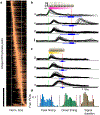Hidden neural states underlie canary song syntax
- PMID: 32555461
- PMCID: PMC7380505
- DOI: 10.1038/s41586-020-2397-3
Hidden neural states underlie canary song syntax
Abstract
Coordinated skills such as speech or dance involve sequences of actions that follow syntactic rules in which transitions between elements depend on the identities and order of past actions. Canary songs consist of repeated syllables called phrases, and the ordering of these phrases follows long-range rules1 in which the choice of what to sing depends on the song structure many seconds prior. The neural substrates that support these long-range correlations are unknown. Here, using miniature head-mounted microscopes and cell-type-specific genetic tools, we observed neural activity in the premotor nucleus HVC2-4 as canaries explored various phrase sequences in their repertoire. We identified neurons that encode past transitions, extending over four phrases and spanning up to four seconds and forty syllables. These neurons preferentially encode past actions rather than future actions, can reflect more than one song history, and are active mostly during the rare phrases that involve history-dependent transitions in song. These findings demonstrate that the dynamics of HVC include 'hidden states' that are not reflected in ongoing behaviour but rather carry information about prior actions. These states provide a possible substrate for the control of syntax transitions governed by long-range rules.
Conflict of interest statement
Competing interests
The authors declare no competing interests
Figures














Comment in
-
Canaries record song history.Nat Rev Neurosci. 2020 Sep;21(9):450-451. doi: 10.1038/s41583-020-0351-x. Nat Rev Neurosci. 2020. PMID: 32669661 No abstract available.
References
-
- Nottebohm F, Stokes TM & Leonard CM Central control of song in the canary, Serinus canarius. J. Comp. Neurol 165, 457–486 (1976). - PubMed
-
- Hahnloser RHR, Kozhevnikov AA & Fee MS An ultra-sparse code underlies the generation of neural sequences in a songbird. Nature 419, 65–70 (2002). - PubMed
-
- Rokni U, Richardson AG, Bizzi E & Seung HS Motor learning with unstable neural representations. Neuron 54, 653–666 (2007). - PubMed
Publication types
MeSH terms
Grants and funding
LinkOut - more resources
Full Text Sources
Miscellaneous

